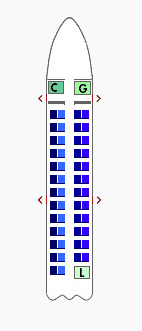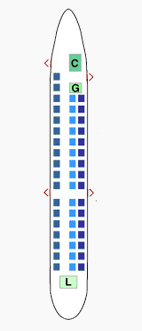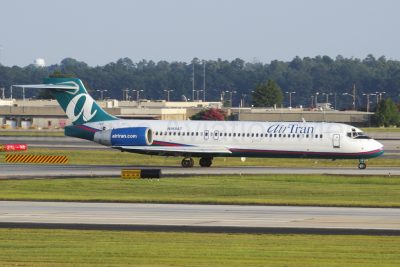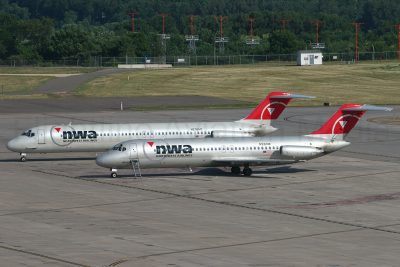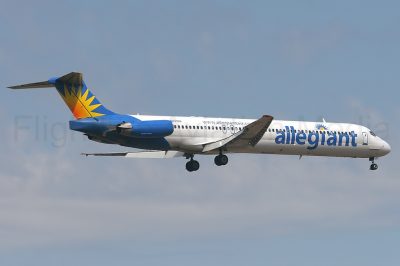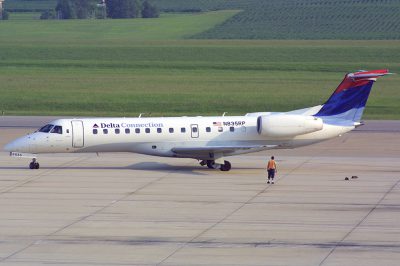2 Engines on the Tail
There are two kinds of jets with their engines on the tail: regular jets and regional jets. Regional jets such as the Canadair Regional Jet (CRJ) and Embraer Regional Jet (ERJ) can only seat 50 or 70 passengers and get their name because their short distance range only allows them to operate within a certain region of the country. The regular size jets are the Douglas DC-9, McDonnell-Douglas MD-80 & MD-90, and Boeing 717 which are all extremely similar and based on the same design. Place your mouse over the red links below to see the illustration highlighted.
Background
What to Look For
There are 5 different versions of the DC-9 and all differ in length. What sets the DC-9 apart from some MD-80s and all MD-90 and 717 models is the pointed shape of the tailcone. The DC9 has 2 baggage compartment doors on the lower right side of the fuselage.

There are 5 different versions of the DC-9 and all differ in length. What sets the DC-9 apart from some MD-80s and all MD-90 and 717 models is the pointed shape of the tailcone The DC9 has 2 baggage compartment doors on the lower right side of the fuselage.

There are 5 different versions of the DC-9 and all differ in length. What sets the DC-9 apart from some MD-80s and all MD-90 and 717 models is the pointed shape of the tailcone The DC9 has 2 baggage compartment doors on the lower right side of the fuselage.

The MD-80 series can be recognized by the wedge shape of its tailcone.
Also, all MD-80 & MD-90 aircraft have small horizontal fins on either side of the fuselage under the cockpit (not shown in the illustration) which are called “strakes”. This helps improve aerodynamic stability.

The MD-80 series can be recognized by the wedge shape of its tailcone Also, all MD-80 & MD-90 aircraft have small horizontal fins on either side of the fuselage under the cockpit (not shown in the illustration) which are called “strakes”. This helps improve aerodynamic stability.

The MD-80 series can be recognized by the wedge shape of its tailcone. Also, all MD-80 & MD-90 aircraft have small horizontal fins on either side of the fuselage under the cockpit (not shown in the illustration) which are called “strakes”. This helps improve aerodynamic stability.

The main difference in the MD-90 is its engines – larger and more tapered appearance than the earlier models. DC-9 and MD-80 aircraft are powered by Pratt & Whitney while these MD-90 engines are the IAE V2500, the most powerful engine to be mounted to the tail of an aircraft.
All MD80 & MD90 aircraft have 3 baggage compartment doors on the lower right of the fuselage and the MD-90 is the longest of all these jets.

The main difference in the MD-90 is its engines – larger and more tapered appearance than the earlier models. DC-9 and MD-80 aircraft are powered by Pratt & Whitney while these MD-90 engines are the IAE V2500, the most powerful engine to be mounted to the tail of an aircraft.
All MD80 & MD90 aircraft have 3 baggage compartment doors on the lower right of the fuselage and the MD-90 is the longest of all these jets.

The main difference in the MD-90 is its engines – larger and more tapered appearance than the earlier models. DC-9 and MD-80 aircraft are powered by Pratt & Whitney while these MD-90 engines are the IAE V2500, the most powerful engine to be mounted to the tail of an aircraft.
All MD80 & MD90 aircraft have 3 baggage compartment doors on the lower right of the fuselage and the MD-90 is the longest of all these jets.

The Boeing 717 is shorter and its engines are longer than an MD-90 and much larger than an MD-80/DC-9. The engines are made by BMW/Rolls-Royce. On most 717s, there will be a title “Boeing 717” either on the front near the door or on the engine cover so it is pretty obvious which is the 717.

The Boeing 717 is shorter and its engines are longer than an MD-90 and much larger than an MD-80/DC-9. The engines are made by BMW/Rolls-Royce. On most 717s, there will be a title “Boeing 717” either on the front near the door or on the engine cover so it is pretty obvious which is the 717.

The Boeing 717 is shorter and its engines are longer than an MD-90 and much larger than an MD-80/DC-9. The engines are made by BMW/Rolls-Royce. On most 717s, there will be a title “Boeing 717” either on the front near the door or on the engine cover so it is pretty obvious which is the 717.

The CRJ & ERJ are much smaller than any of the jets above and can be found at most airports in America today. The most obvious difference is that all CRJs have wingtip extensions called "winglets" while only one ERJ model has them – the 145XR version, flown by United Express.
The main differences between the older version (top) and the newer one (bottom) are length and seating capacity. Also, the newer CRJ versions have a pointed "tailcone" housing the APU exhaust similar to the ERJ.


The CRJ & ERJ are much smaller than any of the jets above and can be found at most airports in America today. The most obvious difference is that all CRJs have wingtip extensions called "winglets" while only one ERJ model has them – the 145XR version, flown by United Express.


The CRJ & ERJ are much smaller than any of the jets above and can be found at most airports in America today. The most obvious difference is that all CRJs have wingtip extensions called "winglets" while only one ERJ model has them – the 145XR version, flown by United Express.




Cabin Layout
The cabins of the DC-9/MD-80/MD-90 and 717 aircraft are similar but there are a couple of major differences.
The DC-9 and 717 have one galley in the front and two lavatories at the rear. The MD-80 & MD-90 have two galleys, front and rear as shown in the seat map to the right. The rear galley is 3 rows up from the back and there is a door, which you can see in the illustration above.
The seating configuration is either 2×3 or 3×2 (MD-88 shown in the illustration). EXCEPTION: the MD-87 only is configured like a DC9 except that the row over the wing where the exit is only has one seat on the left and two on the right.
In all of these aircraft, the last three rows will not have a window view because it is blocked by the jet engine.
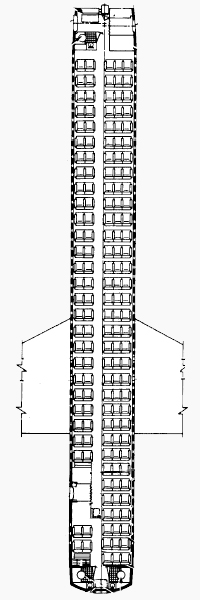
Seating maps are shown for the Canadair & Embraer Regional Jets below.
The CRJ (left) has two across seating, while the ERJ (right) has one left, two right seating. There are a few variants of the CRJ model with a capacity of 50 or 70 passengers; the CRJ-900 model has a first-class seat secion.
Both have one galley (G) and lavatory (L) as shown, but the CRJ-900 model adds an extra for the first class passengers.
